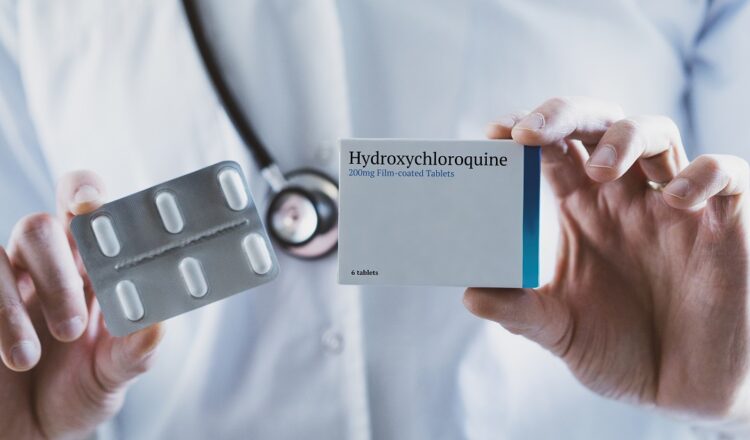That too. As well as malaria and rheumatoid arthritis. As well as Coronavirus Covid 19.
peer review studies HCQ covid 19
https://www.medrxiv.org/content/medrxiv/early/2020/03/30/2020.03.22.20040758.full.pdf
Zhaowei Chen1, , Jijia Hu1, , Zongwei Zhang1 , Shan Jiang2 , Shoumeng Han3 , Dandan Yan4 , Ruhong Zhuang5 , Ben Hu6 and Zhan Zhang7,* 1 Department of Nephrology, Renmin Hospital of Wuhan University, Wuhan 430060, China. 2 Department of Dermatology, Renmin Hospital of Wuhan University, Wuhan 430060, China. 3 Department of Neurosurgery, Renmin Hospital of Wuhan University, Wuhan 430060, China. 4 Department of Pathology, Renmin Hospital of Wuhan University, Wuhan 430060, China. 5 Department of Neurology, Renmin Hospital of Wuhan University, Wuhan 430060, China. 6 CAS Key Laboratory of Special Pathogens, Wuhan Institute of Virology, Center for Biosafety Mega-Science, Chinese Academy of Sciences, Wuhan 430060, China. 7 Department II of Respiratory Disease and Intensive Care, Renmin Hospital of Wuhan University, Wuhan 430060, China. Zhaowei Chen and Jijia Hu contributed equally to this work. * Corresponding author: Zhan Zhang, Department II of Respiratory Disease and Intensive Care, Renmin Hospital of Wuhan University, Wuhan 430060, China. Email:
doctorzhang2003@163.com Abstract Aims: Studies have indicated that chloroquine (CQ) shows antagonism against COVID-19 in vitro. However, evidence regarding its effects in patients is limited. This study aims to evaluate the efficacy of hydroxychloroquine (HCQ) in the treatment of patients with COVID-19. Main methods: From February 4 to February 28, 2020, 62 patients suffering from COVID-19 were diagnosed and admitted to Renmin Hospital of Wuhan University. All participants were randomized in a parallel-group trial, 31 patients were assigned to receive an additional 5-day HCQ (400 mg/d) treatment, Time to clinical recovery (TTCR), clinical characteristics, and radiological results were assessed at baseline and 5 days after treatment to evaluate the effect of HCQ. Key findings: For the 62 COVID-19 patients, 46.8% (29 of 62) were male and 53.2% (33 of 62) were female, the mean age was 44.7 (15.3) years. No difference in the age and sex distribution between the control group and the HCQ group. But for TTCR, the body temperature recovery time and the cough It is made available under a CC-BY-NC-ND 4.0 International license . (which was not certified by peer review) is the author/funder, who has granted medRxiv a license to display the preprint in perpetuity. medRxiv preprint doi:
https://doi.org/10.1101/2020.03.22.20040758.this version posted March 30, 2020.
The copyright holder for this preprint It is made available under a CC-BY-NC-ND 4.0 International license . (which was not certified by peer review) is the author/funder, who has granted medRxiv a license to display the preprint in perpetuity.
CQ and its derivatives have been broadly used as immunomodulators in the treatment of systemic lupus erythematosus (SLE) and other rheumatism [12]. As the pharmacological mechanism of CQ is further elucidated, its additional clinical applications, especially the antiviral activity, are also increasingly valued [13]. The efficiency of CQ has been proven in a variety of viruses, including human coronavirus [[14], [15], [16]]. Researchers have even reported both prophylactic and therapeutic advantages of CQ for SARS-CoV infection [17]. The severe acute respiratory syndrome caused by SARS-CoV-2 in several patients is quite similar to SARS-CoV in 2002 and is currently seriously threatening global health by triggering COVID-19. However, none specific drugs are available for the prevention or treatment of COVID-19. Recently, Wang et al. identified that CQ could effectively inhibit the replication and spread of SARS-CoV-2 in vitro [7]. Experts and guides for COVID-19 in China have also recommended chloroquine phosphate superior to the treatment of SARS-CoV-2 infection [8,9].
To assess the safetyand effects of CQ in patients with COVID-19, we registered this trial in ChiCTR and chose HCQ (the sulfate and phosphate salts of CQ) as the intervention agent.
The data in this study revealed that after 5 days of HCQ treatment, the symptoms of patients with COVID-19 were significantly relieved, manifesting as shorten in the recovery time for cough and fever. At the same time, a larger proportion of patients with pulmonary inflammatory has been partially absorbed in the HCQ treatment group, indicating the immune modulation and anti-inflammatory properties of HCQ in non-malarial diseases [17]. At present, the multiple actions of HCQ such as regulation in pro-inflammatory cytokines [e.g. Tumor necrosis factor-α (TNF-α), interleukin-1 (IL-1), interleukin-1 (IL-6)], antioxidant activities, also promote it widely performed in rheumatic diseases such as SLE [11,17]. According to current research, a higher pro-inflammatory cytokine storm existed in COVID-19 patients with a severe or critical illness, eventually affected the prognosis [18]. For this, IL-6 antibody blocker, transfusion of convalescent plasma, and other therapies have been applied to counteract the cytokine storm [19,20]. Therefore, with antiviral and autoimmune regulation effects, HCQ should be a protector in SARS-CoV-2 infection. In the present study, the reduced risk of progression to severe illness in patients with HCQ treatment also explained the intervention effect of HCQ on the pathological process of the COVID-19. Although HCQ has proven to be effective, with advantages of inexpensive and easily accessible, its potential detrimental effects in viral diseases must also be taken seriously. Retinopathy is one of the major adverse reactions of long-term therapy with HCQ [21]. Besides, patients with rheumatoid diseases treated with HCQ occasionally experience arrhythmias [22]. Other rare adverse reactions caused by HCQ include gastrointestinal reactions, cramps, liver dysfunction, itching, headache, dizziness, insomnia, peripheral neuropathy [13]. Fortunately, deciding on individual treatment plans scientifically, monitoring adverse reactions timely, to avoid overdose, short-term application of HCQ is relatively safe.
Conclusion Despite our small number of cases, the potential of HCQ in the treatment of COVID-19 has been partially confirmed. Considering that there is no better option at present, it is a promising practice to apply HCQ to COVID-19 under reasonable management. However, Large-scale clinical and basic research is still needed to clarify its specific mechanism and to continuously optimize the treatment plan.
1
1


